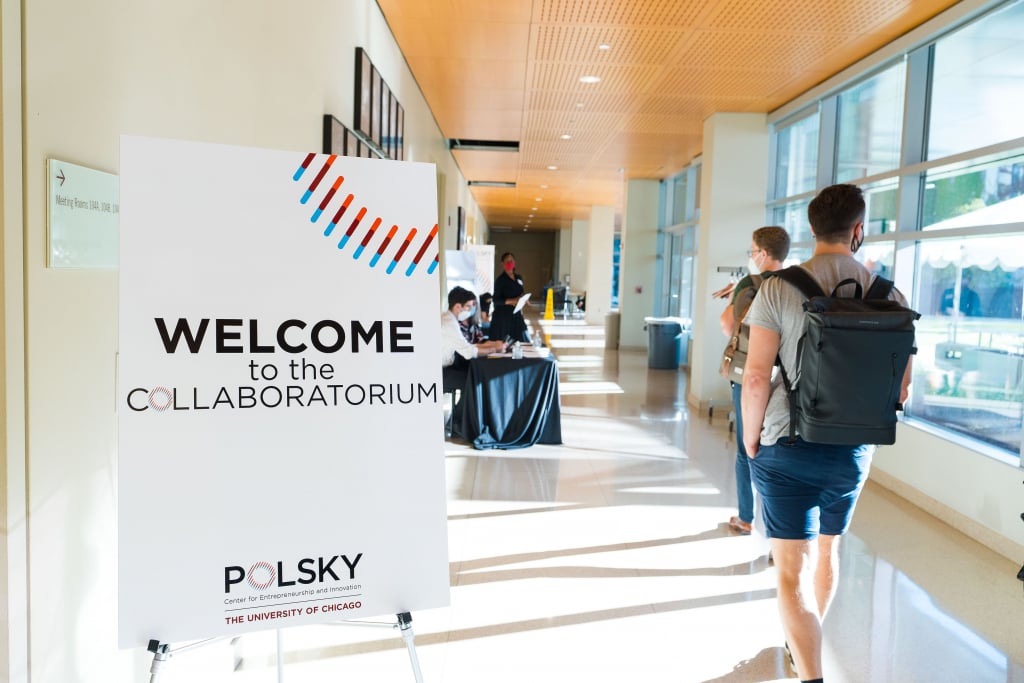Winter Collaboratorium to Connect Students, Scientists Showcasing a Range of Innovations

(Photo credit: eClarke Photo)
The winter Collaboratorium will connect innovators from UChicago Medicine, the Physical Sciences Division, and Argonne’s Chain Reaction Innovations program with University of Chicago students.
The Collaboratorium provides the opportunity for scientists and researchers who want to explore commercialization opportunities to showcase their work and network with students and alumni who may be interested in connecting to pursue further academic study, market research, a business partnership, or participation in experimental programming, such as the Polsky I-Corps Program.
>> Register for the Collaboratorium pitch and networking event
“The Collaboratorium is a unique opportunity to bring together scientists and students, particularly Booth MBA students, who might not otherwise interact on campus,” said Ellen Zatkowski, Polsky Center senior associate director and manager of the Collaboratorium. “Through these connections, we have seen the launch of incredibly successful startups who are able to leverage world-class technical expertise and unparalleled business acumen.”
Taking place Tuesday, February 28th, this year’s winter Collaboratorium will feature a diverse range of projects spanning healthcare, materials science, and sustainability from innovators across UChicago Medicine, the Physical Sciences Division, and Argonne’s Chain Reaction Innovations program.
“This cross-section of cutting-edge innovations from across the University and national labs highlights the incredible work by our scientists, clinicians, and researchers, and is a tremendous opportunity for students to make an impact,” said Zatkowski.
Teams include:
- Aeternal // The team is commercializing a technology that converts plastic trash into chemical feedstocks for consumer goods. They are specifically focusing on creating waxes that have lower greenhouse gas emissions associated with production, reducing manufacturers’ carbon footprint and advancing a circular carbon economy.
- Team: Ryan Hackler, cofounder and CEO, Chain Reaction Innovations, Argonne National Laboratory; Robert Kennedy, cofounder and CTO, Chain Reaction Innovations, Argonne National Laboratory
- AI4MIND // As part of their work at Argonne’s Center for Nanoscale Materials, the team is developing efficient algorithms that harness the power of reinforcement learning to improve scalability and efficiency of current state-of-the-art computational methods for designing and developing new materials.
- Team: Partha Sarathi Dutta, student, University of Illinois-Chicago/Argonne National Laboratory; Suvo Banik, student, University of Illinois-Chicago/Argonne National Laboratory
- Digital Sharps Counter // Medical professionals currently must count all sharps in the operating room by hand on pen and paper, which is prone to error. The team is developing a technology to aid in digitizing sharps counting via an integration of novel software with in-room hardware for quick and efficient tracking of type and quantity of sharps used.
- Team: Omer Raheem, assistant professor of surgery, Biological Sciences Division; Mohamed Kamel, professor of clinical, University of Cincinnati
- GEARBOx // Decision-support tool for use by clinicians and nurse navigators to identify potential clinical trials for their patients, based on the patient’s clinical and genomic testing and information abstracted from the trial protocol.
- Team: Luca Graglia, director of software and infrastructure services, Biological Sciences Division; Samuel Volchenbaum, associate professor of pediatrics, associate director, institute for translational medicine, associate chief, research informatics officer, dean of master’s education, Biological Sciences Division
- Robust Conductive Coordination Polymer Inks // The team has discovered a new polymer, which is highly conductive and highly robust to air, water, heat, and other chemicals. This material can also be processed into solution-processable inks that can be used as coatings on a variety of substrates.
- Team: John Anderson, associate professor, Physical Sciences Division; Patrick Crossland, post-doctoral researcher, Physical Sciences Division
- Universal Adaptor for D&E and D&C’s // The team has developed an adaptor that transforms any suction canister into a canister that will accommodate tubing for abortion procedures.
- Team: Robin Kellogg, staff, Biological Sciences Division; Joseph Leitzke, staff, Biological Sciences Division
// Questions? Contact Ellen Zatkowski at ellen.zatkowski@chicagobooth.edu.